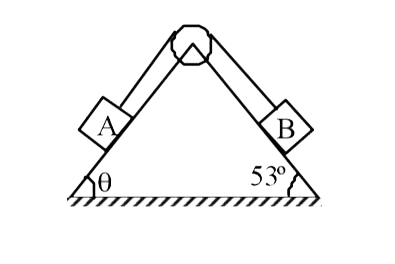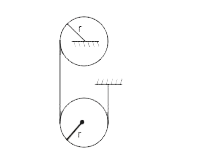Two uniform solid cylinders A and B each of mass 1 kg are connected by a spring of constant 200Nm−1 at their axles and are placed on a fixed wedge as shown in fig.There is no friction between cylinders and wedge. The angle made by the line AB with the horizontal, in equilibirum is

0∘
15∘
30∘
None of these
In equilibrium, there will not be any friction between the cylinder and the wedge. If θ be the required angle
Cylinder A:mgsin60∘=kxcos(60∘−θ)(−mgcos30∘)
Cylinder B:mgsin30∘=kxcos(30∘+θ)=kxsin(60∘−θ)
∴cot30∘=cot(60∘−θ)⇒θ=30∘.
Topper's Solved these Questions
- GMP ASSESMENTBOOK - FIITJEECHAPTER - GMP ASSESMENTEXERCISE - Assertion & Reason
15 Videos
- GMP ASSESMENTBOOK - FIITJEECHAPTER - GMP ASSESMENTEXERCISE - Multiple Question
58 Videos
- GMP ASSESMENTBOOK - FIITJEECHAPTER - GMP ASSESMENTEXERCISE - Numerical Based
61 Videos
- GENERAL PHYSICSBOOK - FIITJEECHAPTER - GENERAL PHYSICSEXERCISE - MATRIX MATCH TYPE
3 Videos
- GRAVITATIONBOOK - FIITJEECHAPTER - GRAVITATIONEXERCISE - Numerical based Question
2 Videos
Similar Questions
Two masses A and B of mass 15kg and 6kg are connected by a string passing over a friction pulley fixed at the corner of a table as shown in The coefficient of friction between A and table is 0.3 the minimum mass (in kg) of that must be placed on A to prevent it from moving is
 .
.
View SolutionAs shown in figure two blocks A and B of mass 1kg each are connected by an ideal string that passes over a smooth pulley that is fixed on a smooth fixed wedge as shown. If the ratio of normal reaction on block A and on block B is 43 then -

View Solution
Knowledge Check
Two blocks A and B of masses 5kg and 2kg respectively connected by a spring of force constant =100Nm−1 are placed on an inclined plane of inclined 30∘ as shown in figure If the system is released from rest
 AThere will be no compression or elongation in the spring if all surface are smoothBThere will be no compression or elongation in the spring if A is rough and B is smoothCMaximum elongation in the spring 35cm If alll surface are smoothDThere will be no compression or elongation in the spring if A is smooth and B is rough
AThere will be no compression or elongation in the spring if all surface are smoothBThere will be no compression or elongation in the spring if A is rough and B is smoothCMaximum elongation in the spring 35cm If alll surface are smoothDThere will be no compression or elongation in the spring if A is smooth and B is roughA block of mass 1 kg is placed on a wedge shown in figure. Find out minimum coefficient of friction between wedge and block to stop the block on it.
 A0.6B0.9C1D0.2
A0.6B0.9C1D0.2Two wedges, each of mass m, are placed next to each other on a flat horizontal floor. A cube of mass M is balanced on the wedges as shown in figure. Assume no friction between the cube and the wedges, but a coefficent of static friction μ<1 between the wedges and the floor. What is the largest M that can be balanced as shown without motion of the wedges ?
 Am√2Bμm√2Cμm1−μD2μm1−μ
Am√2Bμm√2Cμm1−μD2μm1−μ
Two uniform cylinders, each of mass m=10 kg and radius r = 150 mm, are connected by a rough belt as shown. If the system is released from rest, determine
the tension in the portion of the belt connecting the two cylinders.

View SolutionTwo blocks of mass 10 kg and 2 kg are connected by an ideal spring of spring constant K=800N/m and the system is placed on a horizontal surface as shown.

The coefficient of friction between 10 kg block and surface is 0.5 but friction is absent between 2 kg and the surface. Initially blocks are at rest and spring is relaxed. The 2 kg block is displaced to elongate the spring by 1 cm and is then released. (a) Will 10 kg block move subsequently? (b) Draw a graph representing variation of magnitude of frictional force on 10 kg block with time. Time t is measured from that instant when 2 kg block is released to move.
View SolutionTwo uniform solid cylinders, each of mass m = 10 kg and radius r = 150 mm, are connected by a rough belt as shown. If the system is released from rest, determine the velocity of the centre of cylinder A after it has moved through 1.2 m & the tension in the portion of the belt connecting the two cylinders.

View SolutionTwo very small particles 1 and 2 each of mass 0.5kg and of charge q1=1mc and q2=1μC resepectivley are connected by a mass less spring of spring constant 200Nm−1 and placed on a horizontal rough surface.The particle 1 is fixed and 2 is free to move ,Initially the spring is in its natural length (2m) where q2 is released.If coefficient of static friction between 2 and horizontal surface is 0.5 the separation between the charges when they are in equilibrium will be (Neglect gravitational interactions between 1 and 2g=10ms−2
View SolutionA uniform plank of mass m=1kg, free to move in the horizontal direction only, is placed at the top of a solid cylinder of mass 2m and radius R. The plank is attched to a fixed wall by means of light spring of spring constant k=7N/m2. There is no slipping between the cylinder and the plank, and between the cylinder and the ground. the angular frequency of small oscillations of the system is

View Solution
